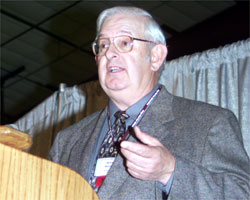|
When all is said and done, what really matters in cattle reproduction on the ranch?
Gordon Niswender, Reproductive Physiologist, CSU

Gordon Niswender, reproductive physiologist, said the future of the beef industry is sexed semen. Using this technology beef producers will be able to use first-calf heifers to produce replacement heifers to achieve more rapid genetic improvement. |
The most important component of a profitable beef operation is reproductive performance. Traits associated with reproduction are estimated to have five to 10 times more economic value to commercial beef cattle production than traits associated with calf growth or milking ability of the cow. According to Gordon Niswender, reproductive physiologist at Colorado State University (CSU), a small investment in improving reproductive performance is likely to provide a higher rate of return than any other aspect of the beef production process.
Since genetics account for less than 10% of the variation in reproductive performance, Niswender said producers have far greater opportunity to improve reproductive efficiency through changes in management and the environment. He recommended paying particular attention to replacement heifer development, breeding season, cow herd nutrition and bull fertility.
Niswender suggested that heifers expected to deliver their first calves as 2-year-olds should be ready to conceive by approximately 14 months of age. Development programs should target breeding age weights equal to about 65% of mature weight. To return to estrus and be on schedule with mature cows, first-calf heifers should achieve 80% - 85% of their mature weights and body condition scores (BCSs) of at least 6.5 by calving time.
Long breeding seasons perpetuate poor reproductive performance and decrease cow herd productivity. Niswender recommended adjusting the time of breeding to match the period of the cow’s maximum nutritional requirement with the time of maximum nutrient production by the environment. The first 45-60 days of lactation is the period when nutritional requirements are greatest.
"Matching this nutritional demand with the time when the environment will be providing the most nutritional opportunities will result in less condition loss in the cow, faster gain in the calves, and [will] increase the likelihood of getting the cow bred back in a fixed breeding season," Niswender explained.
The BCS system is one of the best tools for assessing the nutritional status of the cow. Niswender called the cow’s BCS at calving a good predictor of subsequent pregnancy rate. Cows with a BCS of 5 or greater stand a better chance of exhibiting estrus during the breeding season. Adequate BCS at calving time means pregnancy rates are increased, cows become pregnant earlier in the breeding season and fewer services per conception are required. Feeding additional supplement to thin cows (less than BCS 5) at calving can improve pregnancy rates. However, Niswender warned that, typically, pregnancy rates will still be lower than for cows in better condition.
Niswender said he fears too many cattlemen pay too little attention to bull fertility. Cows mated to bulls that have passed a breeding soundness examination (sometimes referred to as a BSE) are more likely to become pregnant at first service. Typically, Niswender said, pregnancy rates can be increased by 6% - 10% by using bulls that pass a breeding soundness examination, compared to bulls of questionable or unknown classification.
"It has been estimated," Niswender said, "that for every dollar invested in bull breeding soundness examinations, producers will reap as much as $17."
Niswender called artificial insemination (AI) a powerful tool for making genetic improvement. From the standpoint of reproductive performance, he lists three primary benefits of AI, which actually stem from the practice of estrus synchronization. Each of the following benefits may also be achieved when using estrus synchronization with natural service.
• Hormone therapy to synchronize estrus in the breeding group increases the percentage of cows that conceive early in the next breeding season.
• A shortened calving season allows more time for cows to recover from calving and return to estrus.
• Pregnancy rates of cows that calved late are increased.
Niswender said the future holds promise for improved reproductive efficiency through AI with sexed semen. The ability to sort sperm, by X or Y chromosome, allows for predetermination of calf gender. When routinely available for commercial application, it will be possible to breed select females with X-bearing semen to produce tailor-made, replacement-quality heifer calves.
— by Troy Smith
Click here to download the presentation (in pdf format).
 You will need Acrobat Reader to view You will need Acrobat Reader to view
Click the image to download a free copy.
Click here to listen to the presentation
You will need Windows Media Player to listen in.
Click here to download a free version.
|
